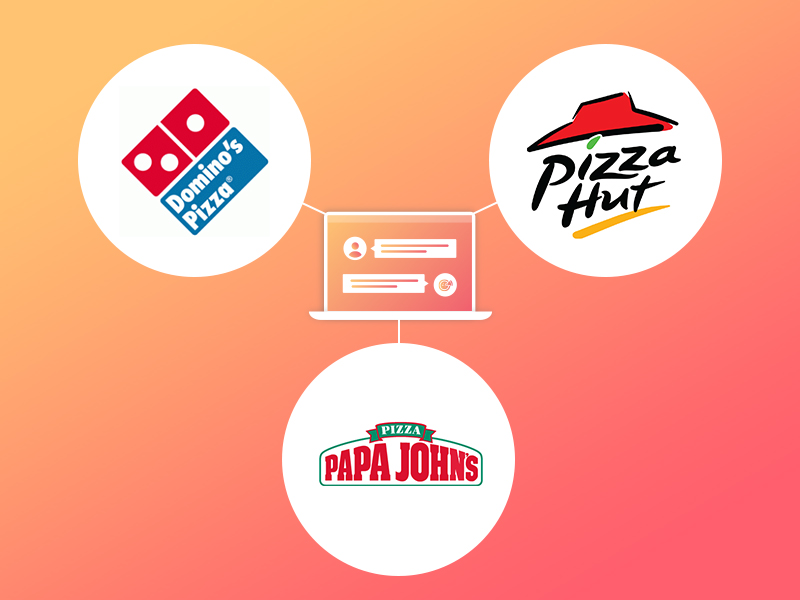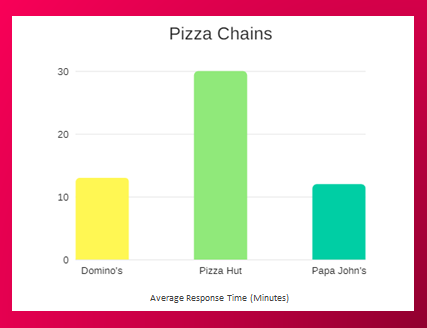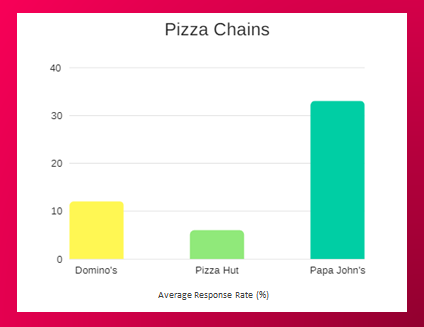
According to BBC findings in 2014, more than 40 million Americans eat pizza in a day. When we talk about pizzas, names like Domino’s, Pizza Hut and Papa John’s come to mind. While these brands are known for their mouthwatering pizzas, do they provide good social media customer service?
This is an important question in the pizza business since much of social media chatter tends to be from customers who complain and enquire about deliveries, product quality, packaging and billing.
To answer the question, we studied recent customer conversations of these brands. Combined with Trooya’s Benchmarking, we present our findings about the brand which rules the roster when it comes to social media customer service.
Below are some crucial parameters to find out how well these chains are performing online customer care:
- Responses to customers on late delivery complaints: How does the brand react to customers who are upset with late delivery of order
- Responses to customers on wrong order delivery complaints: How does the brand react to customers who are saddened by wrong order delivery
- Average response time: What was the average time in which a brand issued a response to a customer
- Average response rate: How many posts from the total volume of posts were responded to by the brand
Now, we’ll begin reviewing all brands on each of these parameters:
- Responses to customers on late delivery complaints:
Domino’s first level response primarily consists of them asking the customers to DM their email address, phone number and store information after expressing their regret for late delivery
This should never happen! Pls DM your name, email, phone#, & store info so we can help. *KV https://t.co/Cf8BiToVpb
— Domino’s Pizza (@dominos) September 12, 2017
In general, Domino’s was mostly seen taking cases offline. While this is a safe approach, but it doesn’t help newer customers see a brand’s prowess in resolving customer concerns.
Pizza Hut has a fairly straight-forward approach. They first enquire whether the customer has attempted to contact their franchise directly. Based on the customer’s feedback, the brand responds. In the example below, Pizza Hut had a personalized approach in responding to the user who complained of a late pizza delivery.
Hey there! Have you received your pizza?
— PizzaHut (@pizzahut) September 25, 2017
Similar to how Domino’s manages delivery related queries, Papa John’s also asks for customers to share their contact details and the franchise from where they ordered. They are also apologetic in situations where the customer is stressed or irritated. In the below instance, the brand apologized and then, tried investigating whether the customer reached out to the store for knowing the status of the order.
Aaron, we’re sorry your order hasn’t arrived. Have you reached out to your local store about the status?
— Papa John’s Support (@AskPapaJohns) September 13, 2017
- Responses to customers on wrong order delivery complaints:
Wrong order delivery related complaints comprise of situations where a delivered pizza differs from a customer’s expectation. Such complaints pertain to there being a significant difference in the delivered pizza’s crust, toppings or side offerings.
In such situations, we observed that Domino’s strategy remains similar to the late delivery complaints. They request customers to share contact and franchise details, which they utilize for their investigation. Domino’s is also seen to empathize in their communication without explicitly apologizing. It’s interesting how they avoid apologizing and yet manage the customer with respect and sensitivity.
We hate disappointing you! Pls DM your name, email, phone#, & store info so we can follow up with you. *KV https://t.co/Cf8BiToVpb
— Domino’s Pizza (@dominos) September 12, 2017
Pizza Hut responds the same way as Domino’s does it, when they have misinterpreted the order. They always ask the customers whether they have reached out to the store or not. As per the customers’ response, the following tweets are personalized. In the below example, when criticized for a wrong order being delivered, Pizza Hut agreed with the customer’s feedback and asked for details to investigate further.
That’s a very good point, Chad. Mind sharing what location this took place at in a DM?
— PizzaHut (@pizzahut) September 11, 2017
Papa John’s is quite apologetic to deliver the wrong order. They ask the customers to DM the details so that the brand can file a complaint with the local store. At times when the situation demands, then only Papa John’s asks the customers to contact the store directly.
We are so sorry to hear about your experience, Brandon. Please DM us and we will file a complaint with the local store. Thanks!
— Papa John’s Support (@AskPapaJohns) September 9, 2017
In the above example, Brandon Lamar slams the brand for late as well as wrong order delivered. In response, Papa John’s expresses deep regret for the customer who had a poor experience with the brand.
- Average Response Time:
Using Trooya’s Benchmarking tool, we derived the average time taken by these brands to respond to customers on Twitter.

Customers who complain on Twitter ideally expect a brand’s response within 30 minutes. Each of the brands we have studied appeared to have their average TATs within 30 minutes. While Papa John’s and Domino’s were found to have near similar TAT, Pizza Hut had an average TAT of exactly 30 minutes.
- Average Response Rate:
Using Trooya’s Benchmarking tool, we derived the average response rate of these brands. Response Rate represents the number of customer queries you have responded to, out of the total number of customer queries present on your social media channels. Higher response rates are indicative of the brand attending to queries and concerns of most customers, if not all.

Currently, the response rate of Papa John’s is 33%. Pizza Hut and Domino’s response rate is quite low with 6% and 12% respectively. Papa John’s has a better response rate in comparison to other pizza chains. As a higher response rate can indicates most customer queries and concerns being covered, brands generally should have a high response rate.
Based on our findings, we have given a weighted score to each parameter that is backed with reasons. This tabular format makes the comparison study of the listed brands easy to understand:
| Domino’s | Pizza Hut | Papa John’s | |
|---|---|---|---|
| Responses for late order complaints | 4/5 | 4/5 | 5/5 |
| Reason: In the sample of responses we checked, 64% of late delivery concerns were responded to in a timely and apologetic manner. There were few cases where the customer didn’t receive a brand response. | Reason: In the sample of responses we checked, only 72% of late delivery concerns were responded to. | Reason: In the observed sample, 84% of late delivery related concerns were managed well by the brand. The published responses seemed to be a mixture of templated and personalised. Closures were also spotted inconsistently. | |
| Responses for wrong order complaints | 3/5 | 4/5 | 5/5 |
| Reason: In the sample of wrong order delivery related concerns we checked, 60% of them were responded to by the brand. While the responses issued were conversational, some cases lacked a brand response or a closure message | Reason: In the observed sample, only 67% of the cases were found to be responded to by the brand. Responses appeared to be templated and less conversational. | Reason: In the observed sample, 90% of the concerns were responded to by the brand. While responses were published for almost all observed cases, they seemed templated and lacked a closure message. | |
| Average Response Time (Minutes) | 5/5 | 4/5 | 5/5 |
| Reason: 13 minutes is a great turnaround time | Reason: 30 minutes is in par with the ideal turnaround time | Reason: Like Domino’s, even Papa John’s is in the same lines when it comes to response time i.e 12 minutes | |
| Average Response Rate (%) | 1/5 | 1/5 | 2/5 |
| Reason: 12% is indicative of having a need to respond to more customer posts | Reason: 6% is a sign that the brand needs to buck up on social media customer service | Reason: 33% response rate indicates that the brand has scope of improvement | |
| Average weighted score | 3.85 | 3.70 | 4.70 |
Note: The observed sample mentions were taken from the August, September and October of this year.
Following are the takeaways derived from our findings:
- Aiming for a first level resolution on social media: Brands should aim to provide resolutions on social media itself. This is not only convenient for the customer, but also sets the tone of how a brand’s customer service is perceived online. Redirecting them for feedback to another channel or the helpline must only be done when a resolution over social media isn’t feasible.
- Maintaining a high response rate: Not replying to a customer’s concern has its consequences. We not only lose the chance of that customer returning, but also risk them spoiling the brand’s image to other potential customers via word of mouth. As social media expert Jay Baer said to Forbes, “A lack of response is a response. It’s a response that says, ‘We don’t care about you very much’.” We’re sure you don’t want your customers feeling that way, which is why it is advisable for you to respond to as many concerns as possible and have a high response rate.
- Issuing a closure response: Whenever a customer shares a concern with a brand, a resolution is provided in broadly 2 ways. Either the brand resolves the concern on social media, or takes the matter offline due to need to investigation. In both cases, when a resolution is attained, the customer should be notified about it on social media. This not only makes the customer feel that they’re being attended, but also helps other users to see the robustness of a brand’s social customer service.
- Apologizing or empathize where needed: Brands should own mistakes made by their online or offline staff. If a branch manager or a delivery agent misbehaved with the customer, the social media team must manage the situation with sensitivity. Having a well thought out response, which includes apology or an empathetic statement which shows that your brand wishes to see their customer at peace, is a good way to manage aggrieved customers. Such an approach makes customers wait for brands to resolve their concerns and possibly even compliment them when the situation gets resolved.
Hope these learnings help your brand to enhance social media customer service!
